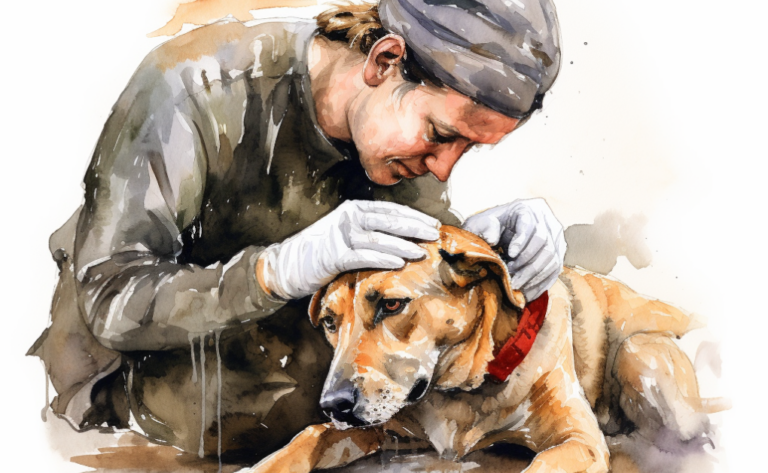What is Fibrosarcoma in Cats?
What is it?
How is it Treated?
Breed Predispositions
It’s important to note that any cat, regardless of breed, can develop fibrosarcoma.
Introduction
As a doting cat parent, Sam took pride in keeping his feline companion, Luna, happy and healthy. One day, however, he noticed a strange lump on Luna’s side that seemed to be growing rapidly. Alarmed, Sam scheduled an appointment with the vet to have Luna examined. The veterinarian performed various tests and revealed that Luna was suffering from fibrosarcoma, a type of aggressive soft tissue cancer. Devastated by the news, Sam realized that he needed to learn more about this condition to ensure that Luna received the best possible care.
Fibrosarcoma in felines is a variant of cancer originating from fibroblasts – the cells responsible for creating connective tissue. This condition arises when certain bodily mechanisms trigger unrestrained growth and accumulation of abnormal fibroblast cells. These fibrosarcomas, which can surface within the connective tissue in various locations, such as the skin, soft tissues, or even bones, are typically characterized by their locally invasive nature. This means they can penetrate surrounding tissues.
It’s crucial to comprehend that cat fibrosarcoma disrupts normal cell growth and division processes, leading to malignant fibrous tumors. This cancer can manifest in several forms, such as squamous cell carcinoma or feline vaccine-associated sarcoma, triggered by certain viruses like feline leukemia or feline sarcoma.
Appreciating how fibrosarcoma transpires in cats is pivotal to the early detection of this disease. Therefore, maintaining a keen eye on your cat’s health and seeking immediate veterinary care when you suspect abnormalities can make a significant difference in managing this condition.
Types of Fibrosarcoma in Cats
In cats, fibrosarcomas can manifest differently depending on their specific characteristics and locations. Here are the types of fibrosarcoma that can occur in cats:
- Cutaneous Fibrosarcoma: This type of fibrosarcoma develops in the skin. It typically presents as a firm, solitary mass within the skin layers. Cutaneous fibrosarcomas can be locally invasive and potentially spread to regional lymph nodes.
- Subcutaneous Fibrosarcoma: Subcutaneous fibrosarcomas arise in the subcutaneous tissues beneath the skin. These tumors are generally well-circumscribed, meaning they have clear boundaries, and they often appear as firm nodules or masses beneath the skin surface.
- Feline Vaccine-Associated Fibrosarcoma (VAF): VAF is a specific form of fibrosarcoma that can develop at the site of previous vaccinations in cats. It is an uncommon but severe complication in response to certain vaccines. VAF is highly locally invasive and has a higher potential for recurrence after surgical removal.
It is important to note that fibrosarcomas can occur in other locations, such as the oral cavity or internal organs. High-grade tumors will metastasize in 25% of cats. However, cutaneous, subcutaneous, and feline vaccine-associated fibrosarcoma are the most commonly recognized types of fibrosarcomas seen in cats. Each type requires proper diagnosis, staging, and treatment planning to provide the best possible care for the affected cat.
Causes of Fibrosarcoma in Cats
While the precise triggers of feline fibrosarcomas are yet to be fully unraveled, numerous factors are conjectured to influence their emergence. It’s crucial to emphasize that the causes described below are speculative and lack definitive evidence as direct instigators of fibrosarcoma in cats. The potential causes incorporate:
Genetic Factors
There are indications from several studies that specific genetic elements may cause certain cats to be predisposed to fibrosarcoma development. Genetic irregularities or mutations within key genes responsible for cellular growth and regulation could be instrumental in facilitating fibrosarcoma in vulnerable cats. However, the specific genetic markers or mutations linked to fibrosarcoma in cats remain unidentified.
Chronic Inflammation
Chronic inflammation within the affected tissues is proposed as a potential instigator for fibrosarcoma development. Repeated or sustained inflammation due to injury, infection, or irritation could result in the accumulation of cellular damage, DNA alterations, and abnormal cell growth, possibly leading to fibrosarcoma formation.
Environmental Triggers
Exposure to certain environmental factors or carcinogens is theorized as a potential risk factor for developing fibrosarcoma in cats.

These factors could include chemicals, radiation, or other toxic substances capable of disrupting normal cellular processes and promoting the emergence of malignant fibrous tumors. However, the specific environmental agents linked to fibrosarcoma in cats remain unidentified.
Vaccination
A specific variant of fibrosarcoma, known as Feline Vaccine-Associated Fibrosarcoma (VAF), can manifest at the site of prior vaccinations. While the precise cause of VAF is obscure, it is theorized to be a complex interaction among genetic factors, inflammation, and immune response to vaccine components. It is essential to note that VAF is a rare complication, and the overall benefits of vaccinations in averting infectious diseases far outweigh the risks.
It’s essential to note that comprehensive research is still needed to unravel the underlying causes and risk factors related to fibrosarcoma in cats. The exact causative mechanisms are ambiguous, and fibrosarcoma is deemed a multifactorial disease influenced by genetic, environmental, and individual factors. This disease impacts cats, particularly in the development of oral tumors or soft tissue sarcomas, and how it correlates to the feline leukemia vaccine are among the many aspects that further research will illuminate. Understanding how to navigate fibrosarcomas depends on this ongoing exploration.
Symptoms of Fibrosarcoma in Cats
Recognizing fibrosarcoma in cats usually entails a detailed examination by a veterinarian. Even though it’s tricky to diagnose feline fibrosarcoma based solely on visible signs, certain symptoms may imply the presence of this condition and justify a deeper investigation. Here are some clues that may hint at fibrosarcoma in cats:
- Manifestation of a Lump: The most prevalent symptom of fibrosarcoma is a hard, detectable lump or mass under the skin. This mass may manifest as a single nodule or be part of a larger cluster of cat tumors.
- Accelerated Expansion: Fibrosarcomas can demonstrate swift expansion over a brief period. If you detect a rapid increase in the size of a mass, it’s crucial to have it assessed without delay.
- Unclear Edges: Fibrosarcomas may possess unclear or irregular edges, making it challenging to differentiate the mass’s periphery from the adjacent tissues.
- Reappearance: A previously surgically extracted mass reemerges in the same spot and could signal a recurrence of fibrosarcoma.
- Discomfort or Distress: Depending on the tumor’s size and location, cats with fibrosarcoma may display signs of discomfort, pain, or even limping.
It’s crucial to note that these signs and symptoms are not exclusive to fibrosarcoma and can also indicate other conditions. Only a comprehensive veterinary examination, which includes a physical assessment and potentially more diagnostic tests like imaging or biopsies, can confirm a definitive diagnosis of fibrosarcoma. If you observe any alarming signs or alterations in your cat’s health, it’s advisable to seek advice from a veterinarian for appropriate evaluation and guidance. Special attention should be given to any signs of ulceration and bleeding, as these could also indicate a progressing condition.
Diagnosis of Fibrosarcoma in Cats
Veterinarians utilize several techniques to pinpoint a diagnosis of fibrosarcoma in cats. These diagnostic strategies can include:
Comprehensive Physical Exam
The veterinarian will meticulously inspect the cat’s body during an extensive physical exam, focusing on any unusual masses, bumps, or abnormalities. The veterinarian will meticulously inspect the cat’s body during an extensive physical exam. They may palpate the suspected area to evaluate the suspected tumor’s size, form, consistency, and position. Moreover, they will check the regional lymph nodes for indications of swelling, which could suggest the potential spread of the tumor within connective tissue or to other areas.
Fine Needle Aspiration (FNA)
Fine needle aspiration employs a slender-gauge needle attached to a syringe to gather a sample of cells and fluid from the suspected tumor. The harvested material is then spread onto slides, dyed, and studied under a microscope.
A veterinary pathologist examines the sample, checking the cellular characteristics to see if they align with the hallmarks of fibrosarcoma.

Tissue Biopsy
A biopsy involves surgically removing a tissue sample from the suspected tumor for more in-depth analysis. Depending on the tumor’s location and accessibility, the biopsy may be conducted through surgical removal, incisional biopsy, or core needle biopsy. The harvested tissue is then dispatched to a veterinary pathologist for histopathological examination.
Histopathological Analysis
Histopathology encompasses a microscopic investigation of the harvested tissue sample by a veterinary pathologist. The pathologist scrutinizes the tissue’s cellular features, structure, and growth patterns. In the context of fibrosarcoma, they will search for specific cellular attributes of malignant fibrous tissue. The results from the histopathological examination confirm fibrosarcoma presence and offer more information about the tumor’s grade (the degree of malignancy), invasiveness, and potential for metastasis, as well as the mitotic index, a measure of the tumor’s growth rate.
Imaging Studies
Imaging techniques like X-rays, ultrasound, computed tomography (CT), or magnetic resonance imaging (MRI) may be employed to gauge the extent of the tumor and the probability of local recurrence. These imaging modalities facilitate the visualization of the location, size, and potential involvement of nearby structures or organs. Imaging can also assess the metastatic spread to other organs in the body.
The amalgamation of these techniques helps veterinarians diagnose fibrosarcoma in cats, ascertain the tumor’s grade and stage, and formulate suitable treatment options. Each diagnostic test contributes to a more comprehensive understanding of the tumor’s attributes and guides decisions related to treatment. Timely and precise diagnosis is vital for effective management and enhanced outcomes for cats with fibrosarcoma, including assessing the risk for tumor recurrence and the potential involvement of factors such as the feline sarcoma virus and injection site sarcoma.
Treatment Options for Fibrosarcoma in Cats
The treatment of fibrosarcoma in cats is multifaceted and depends on various factors, including the tumor’s size, location, stage, and overall cat health. If the cancer is treated effectively, there is a 50% chance your cat will survive for two years.
The choice of treatment strategies is highly personalized and based on several factors, with a unique treatment plan designed for each cat. The veterinary medicine professional will weigh the tumor’s characteristics, location, stage, and the cat’s overall health to determine the most fitting strategy. Regular follow-up examinations and monitoring are required to gauge treatment response, detect recurrent tumors, and manage potential complications.
Therapeutic alternatives for fibrosarcoma in cats might consist of the following:
Surgical Intervention
The surgical excision of the tumor is frequently the primary treatment for fibrosarcoma in cats. The objective is to remove the tumor surgically and a surgical margin of healthy tissue to reduce the risk of recurrence. The surgery’s extent is contingent on the tumor’s location and size. In certain cases, aggressive surgery such as amputation or reconstructive surgery might be necessary to restore the affected area’s shape and function.
Radiation Therapy
Radiation treatment could be proposed as the main therapy or combined with surgery for extensive, invasive fibrosarcomas, or cannot be fully excised. Radiation therapy harnesses high-energy beams to target and eradicates cancer cells, shrink tumor size, avert local recurrence, or provide soothing benefits.
Chemotherapy
Chemotherapy might be employed in cases with evidence of tumor spread or in high-grade or aggressive fibrosarcomas. Chemotherapy encompasses the utilization of drugs that target and destroy cancer cells. The specific chemotherapy agents, dosages, and treatment protocols fluctuate depending on the individual cat and the tumor’s characteristics.
Immunotherapy
Immunotherapy is a novel approach that incites the cat’s immune system to detect and combat cancer cells. This can be accomplished by using specific immunomodulating drugs or vaccines designed to trigger an immune response against the tumor.
Supportive Care
Supportive care measures are integral in managing fibrosarcoma in cats. These may comprise medications to alleviate pain, control inflammation, contain the infection, or address any particular symptoms or side effects linked to the tumor or its treatment. Supportive care aims to maintain the cat’s overall well-being and enhance its quality of life.
A CT scan might be used in conjunction with these treatments to assess the invasiveness of the tumor and guide the surgical removal. In some cases, adjuvant radiotherapy or chemotherapy may be administered after surgical excision to ensure any remaining cancer cells are eradicated.
Prevention of Fibrosarcoma in Cats
Preventing fibrosarcoma in cats can be difficult due to the incomplete understanding of the disease’s exact origins.

However, pet owners can implement several measures to lower the risk or enable early detection of fibrosarcoma potentially:
- Routine Vet Visits: Arrange for your cat to have regular check-ups with the veterinarian. These visits allow the vet to conduct detailed physical exams and track any health changes in your cat. Consistent check-ups can aid in the early identification of any irregularities or masses.
- Awareness of Environment: Aim to limit your cat’s interaction with possible environmental factors that could raise the risk of fibrosarcoma. This includes decreasing their exposure to potential carcinogens such as certain chemicals, toxins, or extensive radiation.
- Vaccination Observation: Although feline vaccine-associated fibrosarcoma (VAF) is rare, monitoring the vaccination sites for any unusual lumps or masses is important. Promptly communicate any worrisome changes to your vet.
- Healthy Living: Maintain a balanced diet for your cat to ensure they receive proper nutrition and prevent excessive weight gain. Regular physical activity and mental engagement also contribute to overall health and wellness.
- Early Detection: Regularly check your cat’s body, looking for new lumps, bumps, or masses. Keep an eye on any changes in existing lumps’ size, shape, or texture. Notify your vet about any concerns, as early detection can significantly influence treatment outcomes. In particular, cats that respond well to early intervention and have the tumor completely removed can significantly reduce the chances of developing a fibrosarcoma recurrence.
Considerations regarding vaccination, such as the feline vaccine and specifically the rabies vaccine, should be discussed with your vet, given their potential connection to inflammation and fibrosarcoma formation.
Frequently Asked Questions
Disclaimer: The information provided on this veterinary website is intended for general educational purposes only and should not be considered as a substitute for professional veterinary advice, diagnosis, or treatment. Always consult a licensed veterinarian for any concerns or questions regarding the health and well-being of your pet. This website does not claim to cover every possible situation or provide exhaustive knowledge on the subjects presented. The owners and contributors of this website are not responsible for any harm or loss that may result from the use or misuse of the information provided herein.







